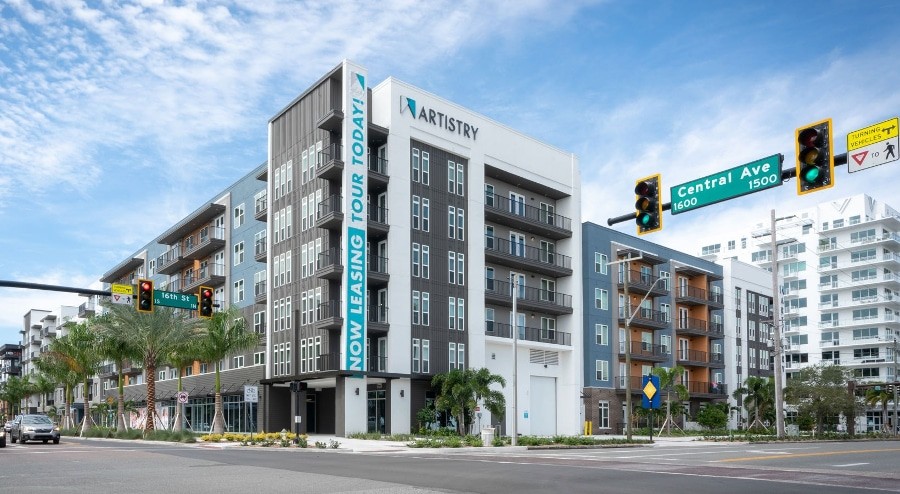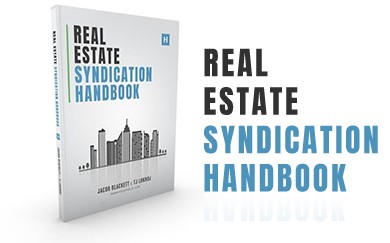More money? We could all do with some of that. Investments made simple? Check. Multifamily assets? I’ll take three, please.
Investors, old and new, are constantly searching for smarter, more efficient ways to grow their capital with real estate.
If you want to secure your financial future, leave the hamster wheel in the dust with a passive cash flow stream, or escape the volatility of trading stocks, investing in multifamily properties is the way to go.
Whether it’s your first acquisition or you want to scale an existing real estate portfolio, buying a multifamily home is a low-risk alternative for you to grow capital passively and easily.
But What is Multifamily Real Estate Investing?
Buying multifamily homes for investment is a great strategy for those who want to benefit from a passive flow of monthly income, while their portfolio assets slowly and steadily appreciate.
Residential building ventures involve purchasing real estate assets with multiple single-family units under one roof. Investors benefit from a higher revenue stream, greater flexibility with their investment strategy, and better property management alternatives, than single-family home owners.
Single-family VS Multifamily Home
Real estate investment properties are divided into two categories, each with distinct investment opportunities and advantages.
On the one hand, traditional single-family homes are single-unit properties designed to accommodate one family. Investors can inhabit the property themselves, or transform it into a rental unit for profit.
On the other hand, there are multifamily properties.
What is a Multifamily Home?
Multifamily property is any residential complex with more than one unit, separated by shared walls within the same structure. On the small scale, low-rise duplex, triplex, and four-plex homes respectively lodge two, three, and four families. Tenements with more than five units are considered commercial real estate, and can scale up to high-rise apartment buildings with hundreds of individual units.
Multifamily assets are valued higher than single-family and require larger capital upfront.
Investors often partner with other buyers to share holding payments, expenses, and property management, making the venture more accessible to individual investors.
Another popular approach is to invest via multifamily crowdfunding platforms like Holdfolio, because entry minimums are low, and property management is undertaken by the syndicator.
This means investors can enjoy a passive monthly cash flow without worrying about tenant acquisition or handover, maintenance, and other hassles associated with the process. Ah, stress-free investment at its finest!
Here are our favorite six reasons to start your multifamily real estate investment journey today.
Cash Flow and Passive Income

In real estate, cash flow is the amount of money that goes directly into an investor’s back pocket each month, after accounting for operating expenses.
With multiple rental units in commercial real estate, investors gain multiple streams of cash flow. Rents are predictable in strong markets and your income will be too.
Passive income is any revenue stream that doesn’t require active involvement. Because multifamily properties entail heavier maintenance and management responsibilities, it’s important to secure property management for your income to be passive.
That’s why so many people opt for Holdfolio crowdfunding investment: their vertically integrated property management company takes care of the ongoing daily responsibilities so investment partners can enjoy hassle-free passive dividends.
What is the 2% Rule in Real Estate?
The 2% rule is a tool used by real estate investors to tell whether or not their investment is worthwhile.
This real estate rule of thumb indicates whether property investments are fruitful by calculating the ratio of revenue to initial expenditure. If the rental yield is equal to or greater than 2% of the total investment value injected into the asset it’s considered a healthy investment. For example, if you invest $50,000 in an asset, your monthly dividends should be $1000 or more.
A Lot Easier to Finance
Banks and financiers tend to base commercial real estate loan approvals on the asset’s profitability because they generate higher revenue than single-family homes.
For the average investor, this means multifamily loans are far more accessible than single-family home loans, simply because the individual’s finances and employment situation are more lightly weighted.
Moreover, commercial real estate requires fewer loans per unit than multiple individual home loans. Typically crowdfunding investment minimums are around $50k. Holdfolio undercuts this barrier to just $20K, so regular people can profit from the same opportunities as pro investors.
Simplicity

Through basic reasoning, we can deduce that obtaining and managing one ten-unit property is simpler than ten individual properties. For example, if you purchase ten single-family homes, you need to negotiate with ten vendors, perform ten separate inspections in ten locations, obtain ten home loans, pay ten transfer fees, and manage ten properties.
With multifamily, you only need to do this once. All units are in the same complex, so procurement and labour are simpler and easier.
Property management in multifamily investing can be a full-time job. High-density housing provides greater flexibility to outsource professional management so you can enjoy passive revenue without lifting a finger, and without cutting into profit margins.
This strategy is particularly attractive for those with little experience in managing rental properties.
Insurance can become more complex as the number of investment units increases (particularly those with higher risk amenities like pools and rooftop terraces). However, most insurance providers are well versed in multifamily assets and assemble comprehensive policies with ease.
As your portfolio grows, it’s usually possible to get a blanket insurance policy encompassing all of your assets from the same provider.
Lowered Risk
People need somewhere to live. That’s never going to change.
Because multi-unit rental structures are more affordable and generally more centrally located than individual homes, there will always be a high demand for these facilities. Further, housing demand is relatively inelastic, meaning that when other economic factors change – such as local rental costs – the need for housing remains stable.
Of course, occupancy rates can affect any property. But if three units of a 100-unit apartment are left vacant, the owners foot less cost than three unoccupied single-family homes.
Buying multifamily homes for investment has a lowered risk, so it is considered a safe investment.
Tax Benefits
Multifamily real estate investing comes with a wealth of financial benefits and tax deductions.
For example, if you have a mortgage to finance the property, you can take a deduction from the mortgage interest paid during the fiscal year. This tends to be higher in the first few years as the loan begins to amortize.
Mechanical systems in multifamily properties, such as electrical, plumbing, and roofing are expensive and durable. But their condition naturally deteriorates over time with use and exposure.
Depreciation is a concept that allows the property owner to account for the annual deterioration of these structures as an “expense.” The depreciation span for multifamily properties is 27.5 years. So, for example, a property worth $1 million could depreciate $36,364 (1,000,000/27.5) per year, even if the property value is technically appreciating.
Asset components devalue at different rates. For example, personal property can depreciate over five to seven years, and sidewalks can depreciate over fifteen years.
Cost segregation is the process of assessing separate physical assets -personal property, land improvements, structures, and land – and calculating their depreciation rate over a shorter period. By splitting individual expenses, you can accelerate the year-on-year depreciation rates of property components, and gain additional tax savings.
It’s critical to have a professional top-to-bottom inspection of the property and leave the calculations to your accountant. This process can be complex, and costly if not done correctly.
Potential Scalability
If you’re looking to grow your investment portfolio, multifamily takes considerably less time to scale than a single property. For instance, acquiring a 20-unit apartment building is much easier and more time-efficient than purchasing twenty separate properties.
Plus, if you plan to buy more rental units in the same building in the future, you can continue to scale your portfolio with less work.
Investors who can occupy a unit within their complex can potentially live expense-free while the other rental units in the property pay off the mortgage, rates, and utilities. Meanwhile, they plan their next multifamily purchase from revenue and equity built in their first investment.
How to Buy a Multifamily Property?

Let’s be honest: the process can take some time and energy.
First, you need to select and inspect your desired property. You choose your financing strategy, then make an offer. Afterward comes renovations to ensure the property is habitable for tenants. The last step is to assemble a management plan. If you wish to outsource to a property management company, make sure you account for this in your expenses.
To many, this process can feel overwhelming. Don’t fret–you still have options. If you want to avoid the menial steps in this operation, opt for crowdfunding.
All you need to do is create an online account, select your investment, and deposit your money. If you prefer a simple and 100% passive investment (and want to skip out on property management responsibilities) sign up with Holdfolio to make the most of the advantages of multifamily real estate investing.
How do you Value Multifamily Real Estate?
Multifamily properties are valued using a simple formula:
Value = Capitalization Rate / Net Operating Income (NOI).
Let me explain:
To determine the NOI, add all the gross rents and other forms of income generated by the property, then subtract annual expenses. In this case, expenses could be renovations, maintenance, property management, depreciation, insurance, and taxes.
The remaining value is the NOI.
A building’s capitalization rate (also known as cap rate) is determined by ‘Purchase Price / NOI.’ Cap rates are variable because both the purchase price and NOI are variable.
Location and local market performance determine the market cap rate, calculated by averaging all the cap rates for comparable properties in the area. To get an idea of what your cap rate should be, ask local brokers, appraisers, and commercial real estate lenders.
Conclusion
The benefits of investing in multifamily properties are undeniable. Assets come with low risk and high demand, scalable portfolios, slow and steady appreciation, and you spend less time dealing with multiple properties in multiple locations.
However, a lot of work goes into selecting and acquiring investments, not to mention the ongoing management and maintenance expenses required to manage the property yourself.
Don’t be discouraged! Do you want to enjoy all the benefits of multifamily investment without lifting a finger? Holdfolio crowdfunding opportunities provide you with high-level investment latitudes without the day-to-day hassle.
All you have to do is create an account, select your property, and make a deposit. It really can be that simple, so join Holdfolio’s team of thriving investors today.
 Back to Blog
Back to Blog




